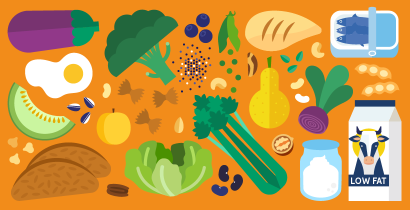What are nutrition and health claims?
Last Updated : 10 July 2024Key takeaways:
- In the EU, food labels may carry two main types of claims: nutrition claims and health claims.
- Nutrition claims highlight the beneficial nutrient content of a food (e.g. “low fat”, “high fibre”, “no added sugar”) and must comply with specific regulatory thresholds.
- Health claims link a food or component to a health effect, such as supporting general health functions, reducing disease risk and promoting children’s growth and development, and must meet strict scientific and quantitative criteria set out in EFSA’s authorisation guidelines.
- Having a nutrition or health claim doesn't mean a product is automatically healthy. The overall nutritional profile (sugar, salt, fat, etc.) is still important.
- Consumers should check the ingredient list and nutrition declaration carefully and consider products in the context of their overall diet rather than relying on claims in isolation.
In today’s health-conscious world, consumers are increasingly seeking information about the nutritional content and health benefits of the foods they consume. As a result, claims about certain properties of the food have gained prominence on food packaging. In the EU, two types of claims are allowed to be made on foods: ‘nutrition claims,’ and ‘health claims'. This article explores what these claims mean and the importance of critically evaluating them to promote better nutrition and overall health.
What are nutrition claims?
Nutrition claims state, suggest or imply that a food has a particular beneficial nutritional property due to its composition (regarding energy or a particular nutrient). They highlight that a product is high or low in a particular nutrient. The high/low level of this nutrient must be clearly marked on the label, close to and with the same prominence as the claim. Nutrition claims are regulated by the European Food Safety Authority (EFSA).
Some common claims that can be found on foods and drinks include:
|
Nutrient |
Nutrition claim |
Definition |
|
Energy |
‘Low energy’ |
<40 kcal per 100 g (solids) or 20 kcal per 100 ml (liquids) |
|
‘Energy-reduced’ |
At least 30% less energy than the regular product |
|
|
‘Energy-free’ |
<4 kcal per 100 ml |
|
|
Fat |
‘Low-fat’ |
<3 g of fat per 100 g (solids) or <1.5 g of fat per 100 ml (liquids) (<1.8 g of fat per 100 ml for semi-skimmed milk) |
|
‘Fat-free’ |
<0.5 g of fat per 100 g or 100 ml |
|
|
‘Low-saturated fat’ |
Saturated & trans-fatty acids are <1.5 g per 100 g (solids) or <0.75 g per 100 ml (liquids) & trans fats must provide <10% of energy |
|
|
‘Saturated fat-free’ |
Saturated & trans-fatty acids are <0.1 g per 100 g or 100 ml |
|
|
Sugar |
‘Low sugar’ |
<5 g of sugars per 100 g (solid) or <2.5 g of sugars per 100 ml (liquids) |
|
‘Sugars-free’ |
<0.5 g of sugars per 100 g (solid) or 100 ml (liquids) |
|
|
‘With no added sugars’ |
No sugars were added during its production; BUT may contain naturally occurring sugars |
|
|
Fibre |
‘Source of fibre’ |
≥3 g per 100 g or ≥1.5 g per 100 kcal |
|
‘High fibre’ |
≥6 g per 100 g or ≥3 g per 100 kcal |
|
|
Protein |
‘Source of protein’ |
At least 12% of the energy of that food comes from protein |
|
‘High protein’ |
At least 20% of the energy of that food comes from protein |
|
|
‘Increased protein’ |
At least 12% of the energy value of food comes from protein and has a 30% increase in protein compared to a similar product |
|
|
Salt |
‘Low salt’ |
<0.3 g of salt per 100 g (solid) or 100 ml (liquids) |
|
‘Very low salt’ |
<0.1 g of salt per 100 g (solid) or 100 ml (liquids) |
|
|
‘Salt-free’ |
<0.0125 g of salt per 100 g (solid) or 100 ml (liquids) |
|
|
‘No added salt’ |
Does not contain any added salt or ingredients containing salt and has <0.3 g of salt per 100 g (solid) or 100 ml (liquids) |
|
|
Vitamin/minerals |
‘Source of [vitamin/mineral]’ |
Contains ≥15% of the nutrient reference values per 100 g or ml (solid) or ≥7.5% per 100 ml (liquids) |
|
‘High in [vitamin/mineral]’ |
Contains at least twice the value of ‘source of’ |
|
|
Other claims |
‘Light/lite’ |
For energy (kcal), fat or sugars: it’s at least 30% less than the regular product For salt: it’s 25% less salt than the regular product |
What are health claims?
Health claims state, suggest or imply that a relationship exists between a food or one of its components and health. Health claims can be divided into three types, the “function health claims”, the “disease risk reduction claims” and the “claims referring to children's development”. Health claims must be based on generally accepted scientific data and be well understood by the average consumer. Non-specific claims about overall health or general well-being may only be made if accompanied by a specific authorised health claim linking a particular substance to a defined health effect. For example, if a product states “Nutritious energy,” it must also include a specific claim such as: “Biotin contributes to normal energy-yielding metabolism.”
A “general function claim” describes how a nutrient or substance can support growth and development, maintain normal physical or mental functions, or help with weight management. An example of a general function health claim is ‘vitamin C contributes to the normal function of the immune system.’ Such a claim can only be made when the product is a ‘source of vitamin C’ or ‘high in vitamin C.’
A ‘disease risk factor reduction’ claim is a specific type of health claim, which states that a food or one of its components significantly reduces a risk factor for human disease. For example, plant sterols can help reduce blood cholesterol, thereby reducing a risk factor for cardiovascular diseases. On the packaging it will state ‘Plant sterols and plant stanol ester have been shown to lower/reduce blood cholesterol. High cholesterol is a risk factor in the development of coronary heart disease.’ To bear this claim, information to the consumer should include that the beneficial effect can be obtained with 1.5-3g of plant sterols per day and the product’s composition must ensure sufficient content to achieve this effect.
A claim referring to children's development highlights the role of a nutrient in supporting children’s growth and health. For example, the claim “Iron contributes to normal cognitive development of children” can only be used for foods which are at least a source of iron, ensuring that the product contains enough of the nutrient to deliver the claimed benefit.
When manufacturers want to make health claims on food products, there are important guidelines to ensure consumers have the necessary information. If a food item makes a health claim, it must include additional information such as a statement emphasising the important of having a diverse and balanced diet and maintaining a healthy lifestyle. This highlights that the claimed benefits are not a substitute for overall healthy habits. In addition, it must also include information on the amount of the food that needs to be consumed to experience the stated positive effects and, if applicable, a statement aimed at individuals who should avoid using the food and a warning for products that may pose a health risk if consumed excessively.
Like nutrition claims, the EFSA approves all health claims in the EU. The accepted list of health claims are available in a public register. For new health claims, a file with the supporting evidence needs to be submitted to EFSA, by the company wishing to make the claim on a food or drink, and the approval procedure followed. For disease risk factor reduction claims and claims on children’s health, more elaborate procedures are in place.
Do claims make a product ‘healthier’?
Claims are used to present products as having an additional health or nutritional benefit. However, it’s important to remember that they don’t take into account the overall nutritional quality of the product, and just because a food product has a nutrition claim doesn’t necessarily mean it’s healthy. For example, a food which is high in fat, salt and/or sugar can still use claims such as ‘rich in vitamin C’ or ‘high in fibre,’ even if the overall health and nutritional benefits of the product are low. If you see any of these claims, check the nutrition declaration and ingredient list to compare between products for the healthiest option. Individual food products with specific nutrition and health claims should also be considered within the broader context of an entire diet. In other words, while certain products may highlight specific benefits, it is the overall variety and balance of foods consumed that play a role in promoting and sustaining good health.
Summary
Nutrition claims are statements that describe the nutritional properties or characteristics of a food, while health claims are statements that link a food component or ingredient to a health outcome. They give information about one specific nutrient only and therefore do not necessarily make a product healthy. Remember, these claims don’t give you the complete picture of a food such as its (added) fat, sugar or salt content. Check the nutrition declaration and ingredient list to compare between products for the healthiest option.
References
- European Parliament, Council of the European Union. (2006). Regulation (EC) No 1924/2006 of the European Parliament and of the Council of 20 December 2006 on nutrition and health claims made on foods.
- European Parliament, Council of the European Union. (2012). Commission Regulation (EU) No 1047/2012 of 8 November 2012 amending Regulation (EC) No 1924/2006 with regard to the list of nutrition claims Text with EEA relevance
- Food and Feed Information Portal Database | FIP



